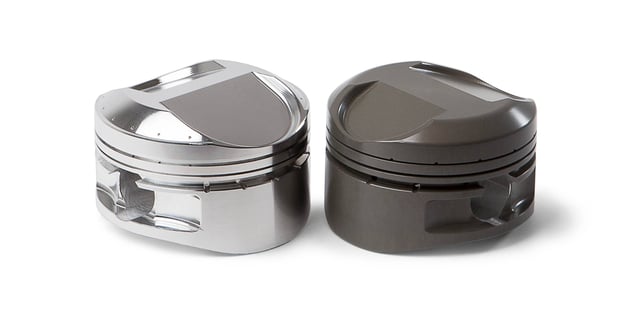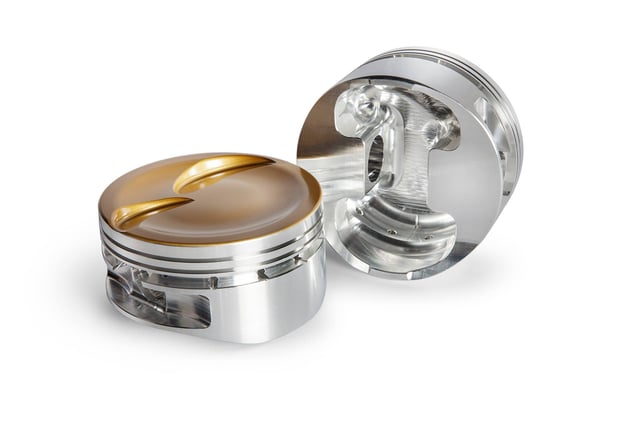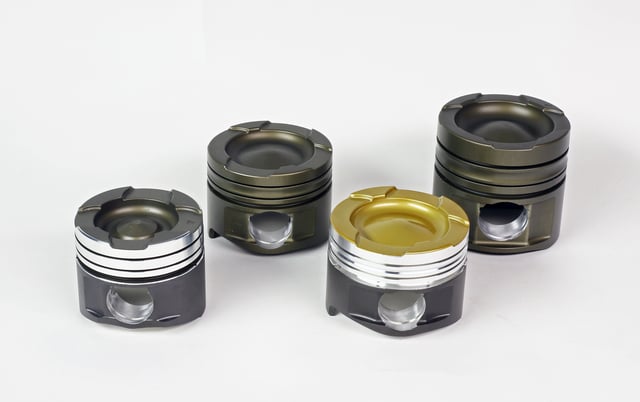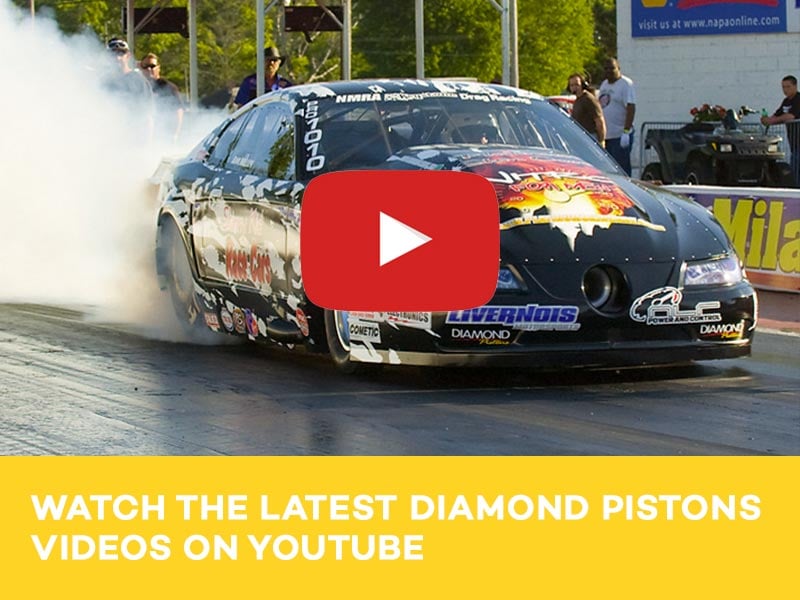Diamond has a host of piston coatings to take your slugs to the next level. Heat resistance, lubricity, hardness, and even dry-start protection are all on the table. Take a walk through Diamond's available coatings and learn how they each work.
Coatings have been around for some time now, and automotive manufacturers were quick to apply the technology to their high-performance products in the never-ending search for increased performance. Diamond Pistons was an early adopter, adding several coatings to their arsenal such as thermal barrier, Type III hard anodizing, moly dry-film anti-friction, PTFE, and DLC (Diamond Like Carbon) coatings for wrist pins. In this article, we'll walk through all of the different coating types, what they do, and how they can improve your piston set.
Type III Hard Anodizing

Of Diamond's coating options, Type III Hard Anodizing is the most essential for added durability. The process penetrates the base material of the piston yielding a surface hardness approaching 70-Rockwell. Hard anodizing enhances component integrity in critical areas such as the ring lands and the piston skirts and also increases heat resistance. Another benefit is prevention of micro-welding between the ring grooves and piston rings, which allows for tighter ring-to-groove clearance and better ring sealing characteristics.
The oxidation layer formed by anodizing becomes part of the parent material and does not flake off. In some OEM applications, only the top ring land is hard anodized in order to increase strength and durability. However, Diamond’s approach is to treat the entire piston, which maximizes strength across the part. A typical hard coating exceeds 25 μm (0.025 mm or 0.0001 inches) and this is accommodated for in the ring and pin machining operations.

Anodizing Benefits
- Thermal barrier protection and increased corrosion- and wear-resistance
- Prevents piston rings from micro welding in ring grooves
- Resists high cylinder temperatures and pressures
Moly, PTFE, and Double Diamond Coatings
One of the drawbacks to an anodized piston is that its substantially hardened skirts can be rough on cylinder walls. To counteract this, Diamond offers two, different coatings “Double Diamond” and "PTFE." Double Diamond pairs the Type III hard anodizing with a molybdenum (moly) skirt coating. This double-coat system provides increased lubricity, with all of the strength benefits of anodizing. The moly is applied directly over the hard anodizing.
The other hard-anodize-compatible coatings is PFTE (the chemical name for Teflon). This coating, unlike Double Diamond, is not simply applied on top of the anodizing. Instead, it is deposited alongside it in one, smooth process. One of the premium coating solutions, PTFE creates a glide barrier that protects the bore and skirt in low oil situations, and also glosses over the abrasive nature of the anodizing.
Spray-on and screen-based moly coatings are extremely prevalent in the piston spectrum due to their ability to protect in low-oil environments (such as cold-start) and the significant reduction in friction they provide. Also, Diamond’s baked-on, moly skirt coating can be applied easily to any Diamond piston (with or without anodizing) and is an investment in power, and longevity.

Ceramic Coating
Ceramic and heat tolerance go hand-in-hand. From kitchen utensils to industrial equipment, ceramic materials have a proven ability to withstand tremendous temperatures, repeatedly. Diamond’s ceramic coating is applied to the piston crown and is used to minimize the amount of heat that enters the piston. The idea is that heat will remain in the combustion chamber where it can flow out the exhaust port, rather than cook the piston.
To validate the significance of ceramic coatings, we must first quantify what happens to a piston that is significantly over heated. The technical term we’re looking for is annealing, which is the softening of a metal after prolonged heating and cooling. In industry, annealing can be both a constructive and destructive process. An annealed part loses hardness and gains ductility, which is, in some cases, a desirable trait. However, in a piston application, it is not. An automotive piston is subjected to a engineered heat treatment process during manufacturing intended to harden it to specified level. After prolonged running at high combustion temperatures, this heat treatment can be lost causing the piston to soften and wear at an accelerated rate.
Ceramic coatings are a step to minimize the aforementioned effects. In particular, these coatings are the most useful in applications with extreme combustion temperatures such as diesel, nitrous, and forced induction applications.

DLC Diamond Like Carbon Coating
In addition to pistons, Diamond also offers a piston pin upgrade with DLC (Diamond Like Carbon) coating for superior surface quality and friction resistance. This upgrade uses Trend Performance coated pins. DLC coatings exhibit a unique combination of a low coefficient of friction and high micro-hardness, making them extremely effective in many high stress automotive applications. DLC coatings offer extreme hardness with excellent flexibility and conformability to all shapes. Most steels peak in the low 60s in Rockwell C, but DLC coatings range in hardness from 70- 90. This provides higher wear resistance, greater performance and less friction at the piston to pin interface.

What Can Coatings Do for Me?
Coatings are not the answer to every automotive problem. They are a means to an end, a way to take a piston’s parent material to the next level and allow it to perform in some way raw aluminum simply cannot. Often, coatings can be combined, to work in harmony for a more robust application. For example, a hard anodizing and ceramic coating can be combined to maximize heat protection in a competition diesel, or moly skirt coatings and a DLC pin added to a high rpm, dry sump road-race motor. Whatever your application, Diamond offers a piston coating that can help.

